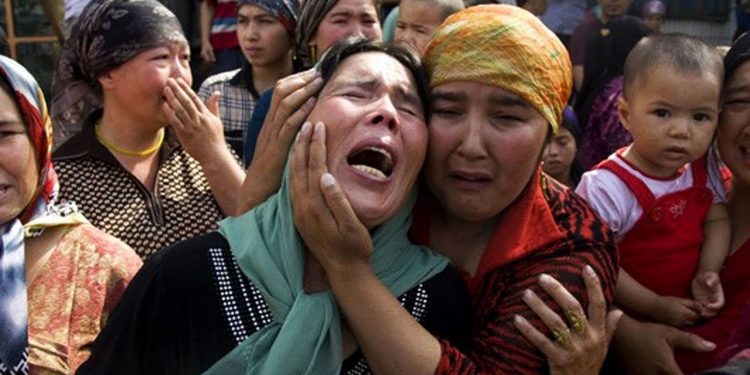Beijing: When police arrested the middle-aged Uighur woman at the height of China’s coronavirus outbreak, she was crammed into a cell with dozens of other women in a detention centre.
There, she said, she was forced to drink a medicine that made her feel weak and nauseous, guards watching as she gulped. She and the others also had to strip naked once a week and cover their faces as guards hosed them and their cells down with disinfectant ‘like firemen’, she said.
“It was scalding,” recounted the woman by phone from Xinjiang, declining to be named out of fear of retribution. “My hands were ruined, my skin was peeling.”
The government in China’s far northwest Xinjiang region is resorting to draconian measures to combat the coronavirus, including physically locking residents in homes, imposing quarantines of more than 40 days and arresting those who do not comply.
Furthermore, in what experts call a breach of medical ethics, some residents are being coerced into swallowing traditional Chinese medicine, according to government notices, social media posts and interviews with three people in quarantine in Xinjiang.
There is a lack of rigorous clinical data showing traditional Chinese medicine works against the virus, and one of the herbal remedies used in Xinjiang, Qingfei Paidu, includes ingredients banned in Germany, Switzerland, the US and other countries for high levels of toxins and carcinogens.
The latest grueling lockdown, now in its 45th day, comes in response to 826 cases reported in Xinjiang since mid-July, China’s largest caseload since the initial outbreak. But the Xinjiang lockdown is especially striking because of its severity, and because there hasn’t been a single new case of local transmission in over a week.
Harsh lockdowns have been imposed elsewhere in China, most notably in Wuhan in Hubei province, where the virus was first detected. But though Wuhan grappled with over 50,000 cases and Hubei with 68,000 in all, many more than in Xinjiang, residents there weren’t forced to take traditional medicine and were generally allowed outdoors within their compounds for exercise or grocery deliveries.
The response to an outbreak of more than 300 cases in Beijing in early June was milder still, with a few select neighbourhoods locked down for a few weeks. In contrast, more than half of Xinjiang’s 25 million people are under a lockdown that extends hundreds of miles from the centre of the outbreak in the capital, Urumqi.
Even as Wuhan and the rest of China has mostly returned to ordinary life, Xinjiang’s lockdown is backed by a vast surveillance apparatus that has turned the region into a digital police state. Over the past three years, Xinjiang authorities have swept a million or more Uighurs, Kazakhs and other ethnic minorities into various forms of detention, including extrajudicial internment camps, under a widespread security crackdown.
Authorities say the measures taken are for the well-being of all residents, though they haven’t commented on why they are harsher than those taken elsewhere. The Chinese government has struggled for decades to control Xinjiang, at times clashing violently with many of the region’s native Uighurs, who resent Beijing’s heavy-handed rule.
Xinjiang authorities can carry out the harsh measures, experts say, because of its lavishly funded security apparatus, which by some estimates deploys the most police per capita of anywhere on the planet.
Not all the recent outbreak measures in Xinjiang are targeted at the Uighurs and other largely Muslim minorities. Some are being enforced on China’s majority Han residents in Xinjiang as well, though they are generally spared the extrajudicial detention used against minorities.
This month, thousands of Xinjiang residents took to social media to complain about what they called excessive measures against the virus in posts that are often censored, some with images of residents handcuffed to railings and front doors sealed with metal bars.
One Han Chinese woman with the last name of Wang posted photos of herself drinking traditional Chinese medicine in front of a medical worker in full protective gear. “Why are you forcing us to drink medicine when we’re not sick!” she asked in a August 18 post that was swiftly deleted.
After the heavy criticism, the authorities eased some restrictions last week, now allowing some residents to walk in their compounds, and a limited few to leave the region after a bureaucratic approval process.
One Han businessman working between Urumqi and Beijing told the AP he was put in quarantine in mid-July. Despite having taken coronavirus tests five times and testing negative each time, he said, the authorities still haven’t let him out – not for so much as a walk.
Since the start of the outbreak, the Chinese government has pushed traditional medicine on its population.
The remedies are touted by President Xi Jinping, China’s authoritarian leader, who has advocated a revival of traditional Chinese culture. Although some state-backed doctors say they have conducted trials showing the medicine works against the virus, no rigorous clinical data supporting that claim has been published in international scientific journals.
The government says that the participation rate in traditional Chinese medicine treatment in the region has “reached 100%”, according to a state media report.
When asked about resident complaints that they were being forced to take Chinese medicine, one local official said it was being done “according to expert opinion.”
AP






































